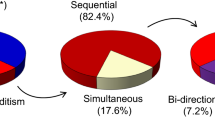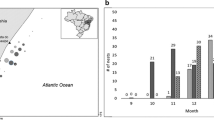Abstract
Coleoid cephalopods show flexibility in their reproductive strategies or mode of spawning, which can range from simultaneous terminal spawning over a short period at the end of the animal’s life to continuous spawning over a long period of the animal’s life. Although a simultaneous terminal spawning strategy is typical of shallow water temperate octopuses, it is not known whether deep-sea octopods would have the same reproductive strategy. The reproductive strategies and fecundity were investigated in nine species of deep-sea incirrate octopuses: Bathypolypus arcticus, Bathypolypus bairdii, Bathypolypus ergasticus, Bathypolypus sponsalis, Bathypolypus valdiviae, Benthoctopus levis, Benthoctopus normani, Benthoctopus sp., and Graneledone verrucosa (total n = 85). Egg-length frequency graphs and multivariate analysis (principal components analysis) suggest that B. sponsalis has a synchronous ovulation pattern and therefore a simultaneous terminal spawning strategy. Although a simultaneous terminal spawning strategy is most likely for B. levis and B. normani, the egg-length frequency graphs and multivariate analysis also suggest a greater variation in egg-lengths which could lead to spawning over an extended period.







Similar content being viewed by others
References
Allcock AL, Collins MA, Vecchione M (2003) A redescription of Graneledone verrucosa. J Moll Stud 69(2):135–143
Allcock AL, Ruggiero H, Collins MA (submitted) Redescription of the deep-sea octopod Benthoctopus normani and description of a new species. Mar Biol Res
Begon M, Townsend C, Harper J (1996) Ecology: individuals, populations and communities. Blackwell, London
Boletzky SV (1974) The larvae of cephalopoda: a review. Thalassia Jugosl 10(1/2):45–76
Boletzky SV (1987) Fecundity variation in relation to intermittent or chronic spawning in the cuttlefish, Sepia officinalis. Bull Mar Sci 40(2):382–387
Boyle PR, Chevis D (1992) Egg development in the octopus Eledone cirrhosa. J Zool Lond 227:623–638
Boyle PR, Daly HI (2000) Fecundity and spawning in a deep-water cirromorph octopus. Mar Biol 137(2):317–324
Boyle PR, Knobloch D (1983) The female reproductive cycle of the octopus, Eledone cirrhosa. J Mar Biol Ass UK 63:71–83
Boyle PR, Rodhouse P (2005) Cephalopods ecology and fisheries. Blackwell, London
Cortez T, Castro BG, Guerra A (1995) Reproduction and condition of female Octopus mimus. Mar Biol 123(3):505–510
Daly HI, Boyle PR, Collins MA (1998) Reproductive status of Opisthoteuthis sp. over an annual cycle. S Afr J Mar Sci 20:187–192
D’Onghia G, Tursi A, Matarrese A, Panetta P (1993) Some aspects of the biology of Bathypolypus sponsalis in the North Aegean Sea. Vie Milieu 43(2–3):161–164
Drazen JC, Goffredi SK, Schlining B, Stakes DS (2003) Aggregations of egg-brooding deep-sea fish and cephalopods on the Gorda Escarpment: a reproductive hot spot. Biol Bull 205:1–7
Eckelbarger KJ, Watling L (1995) Role of phylogenetic constraints in determining reproductive patterns in deep-sea invertebrates. Invert Biol 114(3):256–269
Gage JD, Tyler PA (1991) Deep-sea biology: a natural history of organisms at the deep-sea floor. Cambridge University Press, Cambridge
Grasso M, Di Grande F (1971) Observations on the development and sex differentiation of the gonad in embryos and young specimens of Sepia officinalis. Monitore Zool Ital 5:133–146
Hanlon RT (1983) Octopus joubini. In: Boyle PR (ed) Cephalopod life cycles, vol 1. Academic, London, pp 293–310
Hochberg FG, Nixon M, Toll RB (1992) Order octopoda (Leach, 1818). In: Sweeney MJ, Roper CFE, Mangold KM, Clarke MR, Boletzky SV (eds) “Larval” and juvenile cephalopods: a manual for their identification. Smithson Contr Zool 613:213–279
Laptikhovsky VV (2001) Fecundity, egg masses and hatchlings of Benthoctopus spp. in Falkland waters. J Mar Biol Ass UK 81:267–270
Lewis AR, Choat JH (1993) Spawning mode and reproductive output of the tropical cephalopod Idiosepius pygmaeus. Can J Fish Aquat Sci 50:20–28
Lipps JH, Hickman CS (1982) Origin, age and evolution of Antarctic and deep sea faunas. In: Ernst WG, Morin JG (eds) The environment of the deep-sea, vol 2. Prentice-Hall, Englewood Cliffs, pp 325–356
Mangold (1983) Octopus vulgaris. In: Boyle PR (ed) Cephalopod life cycles, vol 1. Academic, London, pp 335–365
Mangold (1987) Reproduction. In: Boyle PR (ed) Cephalopod life cycles, vol 2. Academic, London, pp 157–200
Mangold KM, Young RE, Nixon M (1993) Growth versus maturation in cephalopods. In: Okutani T, O’Dor RK, Kubodera T (eds) Recent advances in cephalopod fisheries biology. Tokai University Press, Tokyo, pp 697–703
Mangold-Wirz K (1963) Biologie des céphalopodes benthiques de la Mer Catalane. Vie Milieu 8(Suppl 13):1–285
Muus B (2002) The Bathypolypus–Benthoctopus problem of the North Atlantic. Malacologia 44(2):175–222
Nesis KN (1999) The duration of egg incubation in high-latitude and deep-sea cephalopods. Russ J Mar Biol 25(6):499–506
Nesis KN (2001) West-Arctic and East-Arctic distributional ranges of cephalopods. Sarsia 86:1–11
Nixon M (1991) Eggs of Benthoctopus piscatorum. J Zool Lond 223:499–500
O’Dor RK, Malacaster EG (1983) Bathypolypus arcticus. In: Boyle PR (ed) Cephalopod life cycles, vol 1. Academic, London, pp 401–410
Quetglas A, González M, Carbonell A, Sánchez P (2001) Biology of the deep sea octopus Bathypolypus sponsalis from the western Mediterranean Sea. Mar Biol 138(4):785–792
Rocha F, Guerra A, González AF (2001) A review of reproductive strategies in cephalopods. Biol Rev 76:291–304
Rodaniche AF (1984) Iteroparity in the lesser Pacific striped octopus, Octopus chierchiae. Bull Mar Sci 35(1):99–104
Rodríguez-Rúa A, Pozuela I, Prado MA, Gómez MJ, Bruzón MA (2005) The gametogenic cycle of Octopus vulgaris as observed on the Atlantic coast of Andalusia (south of Spain). Mar Biol 147(4):927–933
Roeleveld MAC, Lipiński MR, Augustyn CJ, Stewart BA (1992) The distribution and abundance of cephalopods on the continental slope of the eastern south Atlantic. S Afr J Mar Sci 12:739–752
Salman A, Laptikhovsky VV, Katagan T (2005) Fertility of Indo-Pacific Octopus kagoshimensis males and females in the Eastern Mediterranean sea. Zool Zhurnal 84(2):269–271
Villanueva R (1992a) Continuous spawning in the cirrate octopods Opisthoteuthis agassizii and Opisthoteuthis vossi: features of sexual maturation defining a reproductive strategy in cephalopods. Mar Biol 114(2):265–275
Villanueva R (1992b) Deep-sea cephalopods of the NW Mediterranean: indications of up-slope ontogenetic migration in two bathybenthic species. J Zool Lond 227:267–276
Voight JR, Grehan AJ (2000) Egg brooding by deep-sea octopuses in the North Pacific Ocean. Biol Bull 198:94–100
Voss GL (1967) The biology and bathymetric distribution of deep-sea cephalopods. Stud Trop Oceanogr 5:511–535
Voss GL (1988a) Evolution and phylogenetic relationships of deep-sea octopods (Cirrata and Incirrata). In: Clarke MR, Trueman ER (eds) The mollusca: paleontology and neontology of cephalopods, vol 12. Academic, San Diego, pp 253–276
Voss GL (1988b) The biogeography of the deep-sea octopoda. Malacologia 29(1):295–307
Wood JB, Kenchington E, O’Dor RK (1998) Reproduction and embryonic development time of Bathypolypus arcticus, a deep-sea octopod. Malacologia 39(1–2):11–19
Acknowledgments
We would like to thank the Department of Education and Learning, Northern Ireland, for a research studentship award, the Southampton Oceanography Centre for the loan of specimens, ‘RV Polarstern’ and the Alfred Wegner Institute for opportunities to collect B. levis, Sankurie Pye at the National Museums of Scotland for loans of specimens and Martin Collins at the British Antarctic Survey for additional specimens. We are also grateful to two anonymous reviewers for their advice on the manuscript.
Author information
Authors and Affiliations
Corresponding author
Additional information
Communicated by J.P. Thorpe, Port Erin
Rights and permissions
About this article
Cite this article
Barratt, I.M., Johnson, M.P. & Allcock, A.L. Fecundity and reproductive strategies in deep-sea incirrate octopuses (Cephalopoda: Octopoda). Mar Biol 150, 387–398 (2007). https://doi.org/10.1007/s00227-006-0365-6
Received:
Accepted:
Published:
Issue Date:
DOI: https://doi.org/10.1007/s00227-006-0365-6




